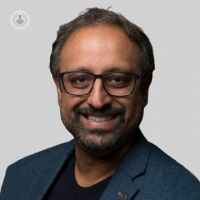ABC approach minimally invasive alternative to radiant smile
Escrito por:A significant number of adults are searching for aesthetic improvements to their smile, but either don’t want to invest their valuable time in comprehensive orthodontic treatment or are unwilling to undergo more invasive procedures, such as veneers or crowns, to achieve their desired results.
Dr Biju Krishnan is an award-winning cosmetic dentist based in London. He presents to us one of his past patients who opted to undergo a minimally invasive procedure using the ABC approach to correct his anterior crossbite. This form of treatment significantly improved his smile without needing to undergo orthodontic treatment or potentially destructive restorative approaches.

The ABC approach
The ABC approach is a progressive strategy to smile design allowing for a minimally invasive treatment plan to be used and, at the same time, meeting the needs of the patients’ aesthetic demands. It can be summarised like this:
- A – Align the anterior (front) teeth. We can do this in several ways in accordance with the patient’s preference.
- B – Bleaching, otherwise known as teeth whitening.
- C – Correction, typically using composite or ceramic to correct any wear or variations in size, shape or colour of the newly aligned teeth.
Case study
Patient AD came to a consultation in 2017, concerned about the appearance of his teeth and wanted a quick restorative solution to improve them. After attending previous orthodontic consultations over the years, he had dismissed the various treatments offered to him due to the time commitment of between 18 and 24 months. Being a semi-professional mixed martial arts competitor, he only had a small window of opportunity every year where he was not competing, so this had an impact on which treatment options he could commit to.
Eventually, he decided to go with an upper and lower fixed orthodontic appliance to align just the anterior teeth - the initial alignment stage. We then decided to follow this up with a course of teeth whitening and composite bonding as needed to round off the treatment.
‘Short-term orthodontics’ (STO) is a term widely used to describe this initial alignment stage, however, it can be misleading and confusing for both dentists and patients, as it implies to be a different form of orthodontic treatment when it is not. Therefore, the term ‘cosmetic tooth alignment’ (CTA), or pre-restorative alignment, paints a more accurate description of this initial phase of the treatment.
Treatment
Patient AD opted for a fixed labial appliance and we used the Cfast self-ligating brace to complete the first stage of treatment. We fitted the brace with brackets held in a laboratory-constructed stent and cemented a quadrant, six brackets each time.
Interproximal reduction (IPR) - a technique used to create space for tooth alignment - was carried out in the upper arch within the UR2 and UR1 of approximately 0.15mm. In the lower arch, IPR was carried out using a 0.1mm IPR strip between all the incisors (narrow teeth along the bottom front of the mouth). A light 0.014-inch nickel-titanium wire was subsequently placed to start moving the teeth.
After five weeks, we reviewed the patient and even after this brief period, there was a notable improvement in his dental appearance. Moreover, one of his main concerns was his anterior crossbite which had already been corrected.
Further IPR was then applied in the lower arch and we referred the patient on to see our hygienist, as we had noticed some gingival inflammation which needed treating.
Four weeks later, the teeth were almost fully aligned and the gingival condition had considerably improved. We continued the alignment in the same way until the patient and I agreed together that the teeth had improved enough to be able to move on to the next stage of treatment.
Whitening and bonding
The patient was offered a home whitening kit consisting of 15% carbamide peroxide to whiten his teeth himself. Once he was satisfied with the level of whiteness, composite bonding was then carried out on certain teeth to improve the incisal edge wear effects and hide some discolouration.

To ensure the stability of the final appearance, we gave him both fixed and removable retainers - which must be stressed from the outset is an indefinite requirement. The patient wasn't interested in metal-bonded lingual retainers, so we used a fibre reinforced composite resin retainer, known as the Single-visit Orthodontic Lingual and Invisible Dual Retainer (SOLID) system - an invisible retainer that prevents post-alignment relapse and is an excellent alternative to metal lingual-bonded retainers.
Takeaway
As we can see in the photos, the ABC approach to smile design gave us the opportunity to achieve a significantly improve the patient’s dental appearance without the need for orthodontic treatment or potentially destructive restorative approaches.
With the development of simple and well-supported cosmetic tooth alignment treatments, you are perfectly able to correct the appearance of your teeth using minimally invasive cosmetic dentistry. It is essential that dentists routinely incorporate these techniques into their treatments of all elective cosmetic and restorative procedures.
It is no longer acceptable in cosmetic dentistry to simply pick up the drill and cut healthy teeth without considering tooth alignment in the treatment planning stage.
Dr Biju Krishnan founded one of the world's leading adult cosmetic tooth alignment systems, known as the CFast (Cosmetically Focused Adult Straight Teeth). If you are interested in receiving this treatment, he is available via e-Consultation to talk through the treatment.


